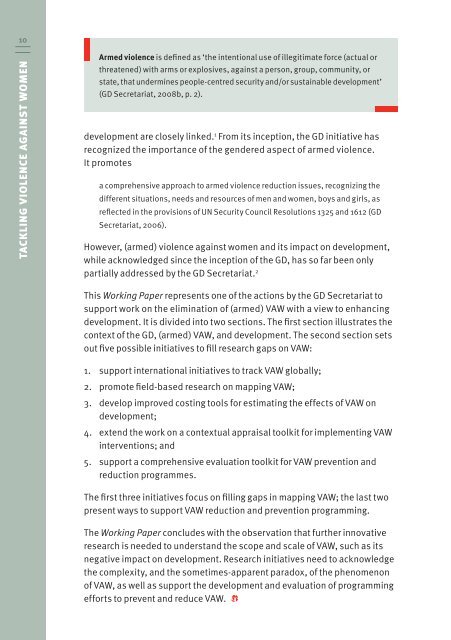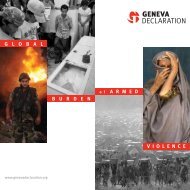Tackling Violence against Women: From Knowledge to Practical
Tackling Violence against Women: From Knowledge to Practical
Tackling Violence against Women: From Knowledge to Practical
Create successful ePaper yourself
Turn your PDF publications into a flip-book with our unique Google optimized e-Paper software.
10<br />
TAckliNG ViolENcE AGAiNsT WomEN<br />
armed violence is defined as ‘the intentional use of illegitimate force (actual or<br />
threatened) with arms or explosives, <strong>against</strong> a person, group, community, or<br />
state, that undermines people-centred security and/or sustainable development’<br />
(gD Secretariat, 2008b, p. 2).<br />
development are closely linked. 1 <strong>From</strong> its inception, the gD initiative has<br />
recognized the importance of the gendered aspect of armed violence.<br />
It promotes<br />
a comprehensive approach <strong>to</strong> armed violence reduction issues, recognizing the<br />
different situations, needs and resources of men and women, boys and girls, as<br />
reflected in the provisions of UN Security Council Resolutions 1325 and 1612 (gD<br />
Secretariat, 2006).<br />
However, (armed) violence <strong>against</strong> women and its impact on development,<br />
while acknowledged since the inception of the gD, has so far been only<br />
partially addressed by the gD Secretariat. 2<br />
This Working Paper represents one of the actions by the gD Secretariat <strong>to</strong><br />
support work on the elimination of (armed) VAw with a view <strong>to</strong> enhancing<br />
development. It is divided in<strong>to</strong> two sections. The first section illustrates the<br />
context of the gD, (armed) VAw, and development. The second section sets<br />
out five possible initiatives <strong>to</strong> fill research gaps on VAw:<br />
1. support international initiatives <strong>to</strong> track VAw globally;<br />
2. promote field-based research on mapping VAw;<br />
3. develop improved costing <strong>to</strong>ols for estimating the effects of VAw on<br />
development;<br />
4. extend the work on a contextual appraisal <strong>to</strong>olkit for implementing VAw<br />
interventions; and<br />
5. support a comprehensive evaluation <strong>to</strong>olkit for VAw prevention and<br />
reduction programmes.<br />
The first three initiatives focus on filling gaps in mapping VAw; the last two<br />
present ways <strong>to</strong> support VAw reduction and prevention programming.<br />
The Working Paper concludes with the observation that further innovative<br />
research is needed <strong>to</strong> understand the scope and scale of VAw, such as its<br />
negative impact on development. Research initiatives need <strong>to</strong> acknowledge<br />
the complexity, and the sometimes-apparent paradox, of the phenomenon<br />
of VAw, as well as support the development and evaluation of programming<br />
efforts <strong>to</strong> prevent and reduce VAw.









